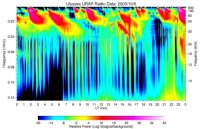Ulysses and Jupiter - Second Rendezvous
29 January 2004
Over the next few weeks, scientists on the joint ESA-NASA Ulysses mission will be turning their attention away from the Sun, and looking at Jupiter instead. In early February, the European-built Ulysses spacecraft will approach the giant planet for a second time. The first encounter, 12 years ago almost to the day, had dramatic consequences for the 350 kg space probe. Like a giant slingshot, Jupiter's immense gravity field propelled Ulysses out of the ecliptic plane, sending it on its way to fly over the poles of the Sun."That was exactly the way the ESA and NASA flight engineers planned it", said Richard Marsden, ESA's Mission Manager for Ulysses. "From its unique, high-inclination orbit, Ulysses has made groundbreaking discoveries that have changed the way we think about the Sun's environment, the heliosphere". February's rendezvous will be much more benign, however. The closest distance between spacecraft and planet will be some 280 times greater than in 1992, so that the orbit of Ulysses will not be changed. Nevertheless, the encounter geometry will enable the instrument teams to make measurements that have not been possible up to now. "Ulysses will approach Jupiter from high northern latitudes, opening a window on previously unexplored parts of the giant planet's magnetosphere", said Marsden. This is of particular interest to scientists studying Jupiter's natural radio emission, since a distinctive type of radio signal is believed to originate in the high-latitude auroral zones of Jupiter.
Back in 1992, the radio and plasma wave experiment on board Ulysses detected radio signals from Jupiter's southern hemisphere that had a strikingly repetitive behaviour. Like a slowly revolving lighthouse, the source of these signals sent out bursts of radio waves approximately every 40 minutes. Unlike a lighthouse, however, the Jovian source was not present continuously. Typically, these so-called "Quasi-periodic", or QP-40 bursts were present for several hours, only to fade away and reappear a number of hours later. In concert with the radio signals, other experiments on Ulysses measured quasi-periodic bursts of energetic electrons. More recently, NASA's Chandra X-ray observatory detected similar QP-40 pulsations in X-rays emitted in hot spots in Jupiter's northern polar regions. Although not fully understood, all of these phenomena seem to be triggered by streams of high-speed solar wind hitting Jupiter's magnetosphere.
 |
|
Jupiter radio emission detected by Ulysses in October 2003 |
Another Jupiter-related investigation is concentrating on a search for streams of dust particles coming from the direction of the planet. Dust streams from Jupiter were discovered by Ulysses in 1992, and seen again more recently by similar instruments on NASA's Galileo and Cassini spacecraft. The dust grains are no bigger than smoke particles, and are believed to originate from Jupiter's volcanic moon, Io. Electromagnetic forces within Jupiter's magnetosphere then propel the particles out of the Jovian system and into interplanetary space, where they appear as streams of dust.
Even though Ulysses does not carry an imager in the conventional sense, one of its on-board experiments is capable of producing images. The GAS instrument on Ulysses works like a pinhole camera. Instead of collecting visible light, however, it collects neutral atoms and UV photons. "The main task of the GAS instrument, which it is doing very successfully, is to detect neutral helium atoms that enter the heliosphere from the surrounding interstellar space", said Richard Marsden. As an added extra, GAS was also able to make images of energetic neutral particles (atoms) escaping from Io's plasma cloud during the first fly-by in 1992. "We'll be tracking Jupiter during the second encounter", said Dr. Manfred Witte, who heads the GAS experiment team. Even though the distance is much greater than in 1992, Witte hopes to make at least one "snapshot".
Because Ulysses' wanderings take it far from the Sun, the onboard power needed to operate the spacecraft's systems and the scientific instruments cannot be obtained using solar cells. Instead, Ulysses carries a Radioisotope Thermoelectric Generator, or RTG, that converts the heat produced by radioactive decay of its plutonium fuel into electricity. The robustness of the spacecraft, coupled with the mission's great success, has allowed Ulysses to operate long past the originally foreseen 5-year lifetime.
Over the years, the RTG output has gradually diminished as the fuel decayed. As a consequence, the spacecraft operations team has had to adopt power-saving measures. "Not only do we have to have enough power to operate the spacecraft and the experiments, we also have to make sure the spacecraft doesn't get too cold", said Nigel Angold, ESA's Spacecraft Operations Manager. Ulysses uses hydrazine thrusters to keep its high-gain antenna pointing towards the Earth. "If we get too cold, the hydrazine could freeze!" said Angold. "So we need to be very careful how we distribute power throughout the spacecraft. Every instrument on board is now considered as a heater as well as a scientific experiment!" Part of the power-saving measures involves operating several of the experiments on a time-sharing basis. Power should not be a problem during the Jupiter encounter period, however. "We've switched off the on-board tape recorders to save power", said Angold. "That will allow us to switch on as many instruments as possible." NASA's Deep Space Network is scheduled to track the spacecraft 24 hours per day between now and mid-March so that the science teams won't have to miss any of the exciting data from Ulysses' second rendezvous with Jupiter.

